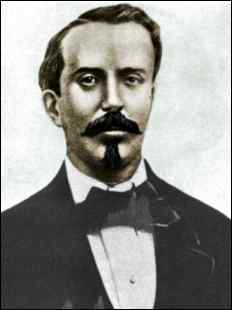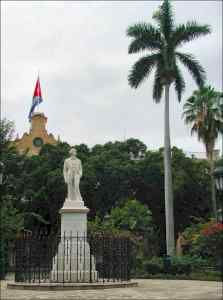

Carlos Manuel de Céspedes
An excerpt from
CUBA: FROM COLUMBUS TO CASTRO
by Jaime
Suchlicki
from Part Two - Towards Independence
Born in Bayamo, Oriente on April 18, 1819, Céspedes attended secondary schools in Havana and later enrolled at the University of Havana. He traveled to Spain to attend college and receive a bachelor of law degree from the University of Barcelona and a doctorate of law from the University of Madrid.
In Spain Céspedes had his first taste of revolution. The Iberian nation was undergoing a period of political turmoil and Céspedes joined the conspiratorial activities of Army General D. Juan Prim against the regime of Baldomero Espartero. The failure of an anti-Espartero uprising in 1843 forced Céspedes to leave the country.
From Spain Céspedes traveled throughout Europe, finally returning to Cuba in 1844. The handsome, cultured, and energetic Céspedes opened a law practice and engaged in business in Bayamo. But law soon gave way to politics, as a strong anti-Spanish movement began to develop in Cuba. Narciso López's unsuccessful filibuster expeditions against Spanish power in Cuba and his subsequent execution in 1851 had an impact on the young Céspedes. Arrested because of his anti-Spanish statements and banished from Bayamo, Céspedes began to organize a war for independence in Oriente province.
After the 1868 "Glorious Revolution" in Spain, he saw an opportunity for revolt in Cuba and called for immediate revolutionary action, claiming that "the power of Spain is decrepit and worm-eaten" and that if it still appeared great and powerful to Cubans it was because "for more than three centuries we have looked at it from our knees."
Céspedes and his group were determined to strike a blow at Spanish control of Cuba. When they learned that their conspiratorial activities had been discovered by the Spanish authorities they were forced to act. On October 10, 1868 Céspedes issued the historic "Grito de Yara" from his plantation, La Demajagua, proclaiming Cuba's independence. He soon freed his slaves and incorporated them into his disorganized and ill-armed force and made public a manifesto explaining the causes of the revolt. Issued by the newly organized Junta Revolucionaria de Cuba, the manifesto stated that the revolt was prompted by Spain's arbitrary government, excessive taxation, corruption, exclusions of Cubans from government employment, and deprivation of political and religious liberty, particularly the rights of assembly and petition. It called for complete independence from Spain, for the establishment of a republic with universal suffrage, and for the indemnified emancipation of slaves.

The manifesto was followed by the organization of a provisional government with Céspedes acting as commander-in-chief of the army and head of the government. Céspedes' almost absolute power as well as his failure to decree the immediate abolition of slavery soon caused opposition within the revolutionary ranks. Facing mounting pressure, Céspedes conceded some of his power and called for a constitutional convention to establish a more democratic provisional government.
Delegates from several eastern towns met at Guáimaro in April 1869 and adopted a constitution that provided for a republican-type government. Unhappy with Céspedes and fearful of concentrating too much power in the office of the president, a faction led by Camagüey's rebel chieftain, Ignacio Agramonte, obtained a large degree of authority for the House of Representatives, including legislative power and control over presidential decisions. This group, as long as it retained power, was also able to legalize the abolition of slavery by introducing Article 24 of the constitution which declared "all inhabitants of the Republic to be absolutely free." Céspedes was elected president of the new republic and Manuel Quesada was appointed commander-in-chief.
Photo above-left by Lina Garcia
Return to 1868
Related:
Struggle for Independence |
Ten Year War |
Little War |
War for Independence